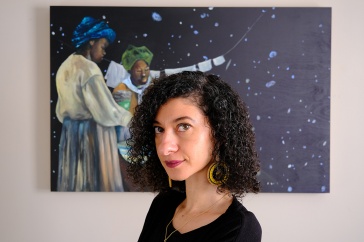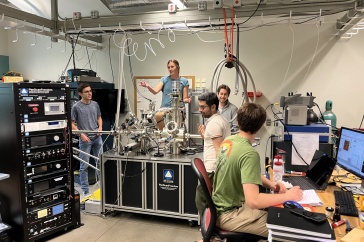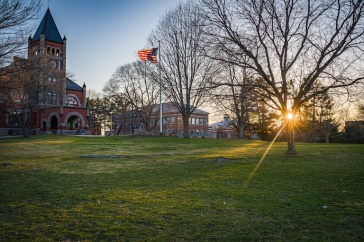
New research from a team of physicists led by UNH significantly advances our understanding of how protons, which comprise 95% of the universe, interact with each other. The results, published recently in the journal Nature Physics, provide a benchmark for testing the strong force, one of the four fundamental forces in nature.
“There’s a lot still unanswered about both of those things, the proton and the strong force,” says lead author David Ruth, a Ph.D. candidate at UNH. “This brings us a little bit closer to that understanding. It’s a necessary piece of two very fundamental things in the universe.”
The strong force governs how what’s internal to the atom’s nucleus — neutrons, protons and the quarks and gluons that make them up — bind together. It is the least understood of the four fundamental forces of nature, which include gravity, electromagnetism and the weak force.
“If we really want to understand our world, we have to have a solid theory of that force,” says professor of physics Karl Slifer, Ruth’s advisor and a lead collaborator on the study.
“There’s a lot still unanswered about both ... the proton and the strong force. This brings us a little bit closer to that understanding. It’s a necessary piece of two very fundamental things in the universe.”
The researchers tested two state-of-the-art, competing theoretical calculations of the strong force with an experiment probing the spin of the protons in a regime, or mode of operating, where the quarks that comprise them are at a great distance from each other. Their experimental findings agreed with one of the calculations but not the other.
“Because these calculation are very complex, each theory group makes different choices about how to do them,” Ruth says about the discrepancy. “Due to some choice the theorists made in these calculations, they ended up different. If we’re going to understand the strong force, we need to know which one is right, which one is wrong.”
Not only were the calculations extremely complex, the experiment itself was no walk in the park. It was conducted a decade ago at the Department of Energy’s Thomas Jefferson National Accelerator Facility; at that time it was the largest ever installation in Jefferson Lab’s Hall A facility.
Neutron Dance
Ruth’s research is the second UNH nuclear physics study to publish in a high-profile journal recently. In August 2022, then-Ph.D. student Shujie Li was lead author on an article in Nature that brings new insights to the interaction of nucleons, the protons and neutrons that form the dense nucleus at the core of the atom. This study provides a unique observation of quarks, the particles that make up protons and neutrons, and helps us understand the cold dense nuclear matter of neutron stars. The work informs other research fields, including astrophysics and neutrino physics.
Li, now working at Lawrence Berkeley National Lab, collaborated on this work with fellow graduate student Nathaly Santiesteban, now an assistant professor of physics at UNH, and the late assistant professor of physics Patricia Solvignon-Slifer. The Department of Energy labeled this experiment “high impact.”
This work was supported in part by the Department of Energy’s Office of Science, Office of Nuclear Physics, and the National Science Foundation.
Read more about the study.
“It took a small army of graduate students, post-docs and technical staff six months to install and another six months to run,” says Slifer , who led the experiment in 2021, in a Nature Research Briefing that accompanies the article. “Along the way we faced many technical challenges.” Ruth, who will finish his Ph.D. in the coming year, analyzed data from the experiment but was not present for it.
The next step in the inquiry into the strong force, says Ruth, is back in the theorists’ hands. “A lot of physics is the theorists and the experimentalists tossing balls to each other. We’re tossing the ball back to the theorists and saying, ‘Why don’t your calculations agree? What needs to be done for them to agree?’”
Slifer can imagine the work moving out of the theoretical or experimental and into practical applications, much as our understanding of interactions between nucleons a century ago gave birth to applications like fission and fusion and nuclear power. “I’m not sure what the applications will be, but that understanding will push new technology in the future,” he says.
In addition to Ruth and Slifer, UNH co-authors on the study were former UNH postdoctoral researcher James Maxwell, now a staff scientist at Jefferson Lab; former graduate students Ryan Zielinski and Toby Badman; assistant professor Elena Long; former postdoc Sara Phillips; and the late assistant professor of physics Patricia Solvignon-Slifer. The work was funded by several Department of Energy grants, including grant DE-FG02-88ER40410 to UNH.
-
Written By:
Beth Potier | UNH Marketing | beth.potier@unh.edu | 2-1566





















































